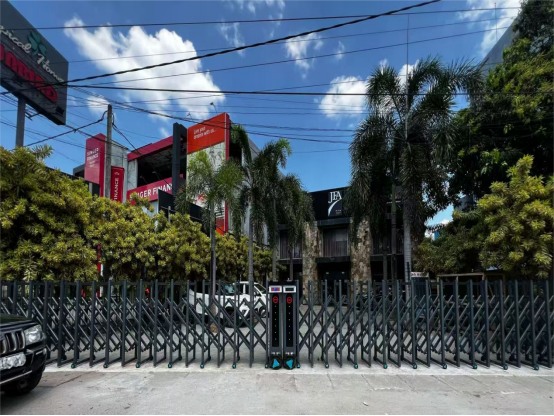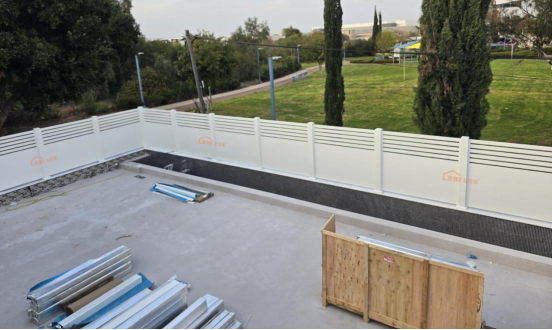

The aluminum gate industry is undergoing a transformative shift as technological advancements, sustainability mandates, and evolving consumer expectations redefine modern entryway systems. From residential properties to commercial complexes, aluminum gates are no longer just functional barriers—they are evolving into intelligent, eco-conscious, and design-forward solutions. This article explores the key trends shaping the future of swing gates, sliding gates, and retractable gates, focusing on smart integration, environmental responsibility, material advancements, and market dynamics.

1. Smart Technology: Revolutionizing Access and Security
The era of manual operation is fading as smart automation becomes integral to aluminum gate systems. Homeowners and businesses now demand seamless connectivity, enhanced security, and energy efficiency, driving manufacturers to innovate.
Automated Access Control: Motorized swing and sliding gates equipped with Wi-Fi or Bluetooth connectivity allow remote operation via smartphones, keypads, or voice assistants. Integration with smart home ecosystems (e.g., Amazon Alexa, Google Home) enables synchronized control with lighting, cameras, and alarms.
Advanced Security Features: AI-powered license plate recognition, facial recognition, and biometric scanners are replacing traditional keypads. Retractable gates with embedded motion sensors and intrusion alerts provide real-time notifications to users’ devices.
Energy Efficiency: Solar-powered gate operators are gaining traction, reducing reliance on grid electricity. Smart systems optimize energy use by adjusting operation speeds or entering sleep mode during inactivity.
Predictive Maintenance: IoT-enabled sensors monitor gate mechanics, alerting users to issues like motor wear, track misalignment, or battery depletion before failures occur.
Leading brands like Nice Group and FAAC are pioneering these technologies, positioning aluminum gates as critical components of smart property management.

2. Sustainability: Eco-Friendly Materials and Practices
As global climate regulations tighten, the aluminum gate industry is prioritizing green manufacturing and circular economy principles.
Recyclability: Aluminum’s 100% recyclability ensures minimal environmental impact. Recycled aluminum requires 95% less energy to process than virgin material, making it ideal for eco-conscious projects.
Low-Carbon Production: Manufacturers are adopting renewable energy sources (e.g., solar, hydro) for smelting and powder-coating processes. Companies like Aluprof and Hörmann now offer carbon-neutral gate solutions.
Energy-Saving Designs: Thermally broken aluminum frames in swing gates prevent heat transfer, improving energy efficiency in adjacent buildings. Solar-integrated sliding gates generate power for self-sustained operation.
Durability and Longevity: Corrosion-resistant alloys reduce replacement frequency, minimizing waste. Powder-coated finishes eliminate toxic VOCs (volatile organic compounds) associated with traditional paints.
With the global green construction market set to exceed $1 trillion by 2027, sustainability is a cornerstone of competitive differentiation.
3. Material and Design Innovations
Aluminum’s versatility continues to inspire breakthroughs in gate design, balancing aesthetics, strength, and adaptability.
High-Strength Alloys: Aluminum alloys enhance load-bearing capacity, enabling slimmer profiles for sliding and retractable gates without sacrificing durability.
Weather-Resistant Finishes: Anodized and PVDF coatings protect against UV radiation, saltwater corrosion, and extreme temperatures—critical for coastal or industrial applications.
Hybrid Systems: Combining aluminum with tempered glass, wood-effect panels, or laser-cut metal inserts meets demand for customized aesthetics.
Space-Saving Solutions: Retractable gates, which fold or roll into compact units, are ideal for urban properties with limited space.
Architects and designers increasingly favor minimalist, large-format aluminum gates that complement modern architectural trends.

4. Customization and Functional Versatility
Today’s buyers seek gates tailored to their unique needs, driving innovation in modular designs and multifunctional systems.
Adaptive Configurations:
Swing Gates: Double or single-leaf designs with adjustable opening angles (e.g., 90° to 180°) for diverse driveway layouts.
Sliding Gates: Trackless magnetic systems eliminate ground rails, reducing tripping hazards and maintenance.
Retractable Gates: Telescoping or folding mechanisms for high-security areas like parking garages or warehouses.
Climate-Specific Features: Hurricane-rated swing gates in storm-prone regions, noise-dampening systems for urban settings, or frost-resistant operators in cold climates.
Aesthetic Personalization: Custom powder-coat colors, decorative scrollwork, and LED lighting integration enhance curb appeal.
5. Market Growth and Regional Opportunities
Valued at $12.8 billion in 2023, the global aluminum gate market is projected to grow at a 5.9% CAGR through 2030, fueled by:
Urbanization in Asia-Pacific: Rapid infrastructure development in India, China, and Southeast Asia drives demand for automated residential and commercial gates.
North America’s Renovation Boom: Homeowners are upgrading to energy-efficient, smart aluminum gates to boost property value and security.
Europe’s Regulatory Push: EU mandates for sustainable building materials and energy-efficient designs accelerate adoption of aluminum systems.
6. Challenges and Strategic Responses
While the industry thrives, it faces hurdles like fluctuating aluminum prices, competition from steel and vinyl, and skilled labor shortages. Forward-thinking companies are addressing these through:
Digital Tools: AI-driven design platforms enable rapid prototyping and reduce material waste.
Localized Production: Regional manufacturing hubs lower logistics costs and carbon footprints.
Collaborative R&D: Partnerships with tech firms enhance smart gate capabilities and cybersecurity protocols.
Conclusion: Pioneering the Next Generation of Entry Solutions
The aluminum gate industry is evolving into a nexus of innovation, sustainability, and user-centric design. From solar-powered sliding gates to AI-driven retractable systems, aluminum’s lightweight durability and adaptability make it the material of choice for future-proof entry solutions.
Businesses that invest in smart technologies, circular production models, and hyper-customizable designs will lead this transformative era, turning gates into dynamic interfaces between security, sustainability, and style.
Email format error
Email cannot be empty
Email already exists
6-20 characters(letters plus numbers only)
The password is inconsistent
Email format error
Email cannot be empty
Email does not exist
6-20 characters(letters plus numbers only)
The password is inconsistent